Intel Core i7 3960X (Sandy Bridge E) Review: Keeping the High End Alive
by Anand Lal Shimpi on November 14, 2011 3:01 AM EST- Posted in
- CPUs
- Intel
- Core i7
- Sandy Bridge
- Sandy Bridge E
No Integrated Graphics, No Quick Sync
All of this growth in die area comes at the expense of one of Sandy Bridge's greatest assets: its integrated graphics core. SNB-E features no on-die GPU, and as a result it does not feature Quick Sync either. Remember that Quick Sync leverages the GPU's shader array to accelerate some of the transcode pipe, without its presence on SNB-E there's no Quick Sync.
Given the target market for SNB-E's die donor (Xeon servers), further increasing the die area by including an on-die GPU doesn't seem to make sense. Unfortunately desktop users suffer as you lose a very efficient way to transcode videos. Intel argues that you do have more cores to chew through frames with, but the fact remains that Quick Sync frees up your cores to do other things while SNB-E requires that they're all tied up in (quickly) transcoding video. If you don't run any Quick Sync enabled transcoding applications, you won't miss the feature on SNB-E. If you do however, this will be a tradeoff you'll have to come to terms with.
Tons of PCIe and Memory Bandwidth
Occupying the die area where the GPU would normally be is SNB-E's new memory controller. While its predecessor featured a fairly standard dual-channel DDR3 memory controller, SNB-E features four 64-bit DDR3 memory channels. With a single DDR3 DIMM per channel Intel officially supports speeds of up to DDR3-1600, with two DIMMs per channel the max official speed drops to 1333MHz.
With a quad-channel memory controller you'll have to install DIMMs four at a time to take full advantage of the bandwidth. In response, memory vendors are selling 4 and 8 DIMM kits specifically for SNB-E systems. Most high-end X79 motherboards feature 8 DIMM slots (2 per channel). Just as with previous architectures, installing fewer DIMMs is possible, it simply reduces the peak available memory bandwidth.
Intel increased bandwidth on the other side of the chip as well. A single SNB-E CPU features 40 PCIe lanes that are compliant with rev 3.0 of the PCI Express Base Specification (aka PCIe 3.0). With no PCIe 3.0 GPUs available (yet) to test and validate the interface, Intel lists PCIe 3.0 support in the chip's datasheet but is publicly guaranteeing PCIe 2.0 speeds. Intel does add that some PCIe devices may be able to operate at Gen 3 speeds, but we'll have to wait and see once those devices hit the market.
The PCIe lanes off the CPU are quite configurable as you can see from the diagram above. Users running dual-GPU setups can enjoy the fact that both GPUs will have a full x16 interface to SNB-E (vs x8 in SNB). If you're looking for this to deliver a tangible performance increase, you'll be disappointed:
| Multi GPU Scaling - Radeon HD 5870 CF | |||||
| Max Quality, 4X AA/16X AF | Metro 2033 (19x12) | Crysis: Warhead (19x12) | Crysis: Warhead (25x16) | ||
| Intel Core i7 3960X (2 x16) | 1.87x | 1.80x | 1.90x | ||
| Intel Core i7 2600K (2 x8) | 1.94x | 1.80x | 1.88x | ||
Modern GPUs don't lose much performance in games, even at high quality settings, when going from a x16 to a x8 slot.
I tested PCIe performance with an OCZ Z-Drive R4 PCIe SSD to ensure nothing was lost in the move to the new architecture. Compared to X58, I saw no real deltas in transfers to/from the Z-Drive R4:
| PCI Express Performance - OCZ Z-Drive R4, Large Block Sequential Speed - ATTO | ||||
| Intel X58 | Intel X79 | |||
| Read | 2.62 GB/s | 2.66 GB/s | ||
| Write | 2.49 GB/s | 2.50 GB/s | ||
The Letdown: No SAS, No Native USB 3.0
Intel's current RST (Rapid Story Technology) drivers don't support X79, however Intel's RSTe (for enterprise) 3.0 will support the platform once available. We got our hands on an engineering build of the software, which identifies the X79's SATA controller as an Intel C600:
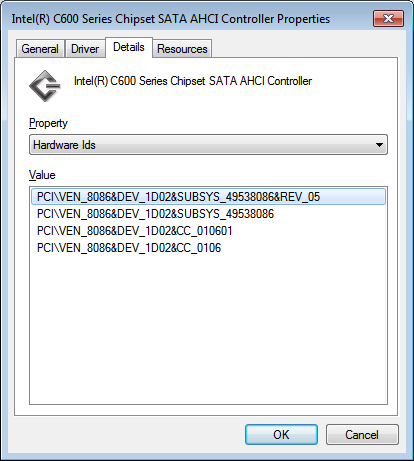
Intel's enterprise chipsets use the Cxxx nomenclature, so this label makes sense. A quick look at Intel's RSTe readme tells us a little more about Intel's C600 controller:
SCU Controllers:
- Intel(R) C600 series chipset SAS RAID (SATA mode)
Controller
- Intel C600 series chipset SAS RAID ControllerSATA RAID Controllers:
- Intel(R) C600 series chipset SATA RAID ControllerSATA AHCI Controllers:
- Intel(R) C600 series chipset SATA AHCI Controller
As was originally rumored, X79 was supposed to support both SATA and SAS. Issues with the implementation of the latter forced Intel to kill SAS support and go with the same 4+2 3Gbps/6Gbps SATA implementation 6-series chipset users get. I would've at least liked to have had more 6Gbps SATA ports. It's quite disappointing to see Intel's flagship chipset lacking feature parity with AMD's year-old 8-series chipsets.
I ran a sanity test on Intel's X79 against some of our H67 data for SATA performance with a Crucial m4 SSD. It looks like 6Gbps SATA performance is identical to the mainstream Sandy Bridge platform:
| 6Gbps SATA Performance - Crucial m4 256GB (FW0009) | ||||||
| 4KB Random Write (8GB LBA, QD32) | 4KB Random Read (100% LBA, QD3) | 128KB Sequential Write | 128KB Sequential Read | |||
| Intel X79 | 231.4 MB/s | 57.6 MB/s | 273.3 MB/s | 381.7 MB/s | ||
| Intel Z68 | 234.0 MB/s | 59.0 MB/s | 269.7 MB/s | 372.1 MB/s | ||
Intel still hasn't delivered an integrated USB 3.0 controller in X79. Motherboard manufacturers will continue to use 3rd party solutions to enable USB 3.0 support.


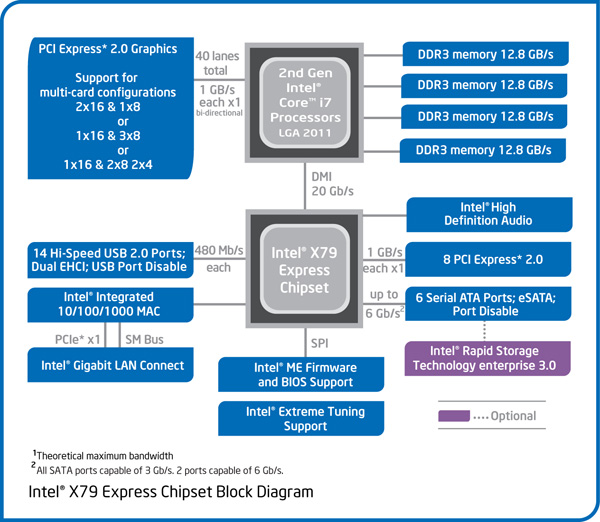
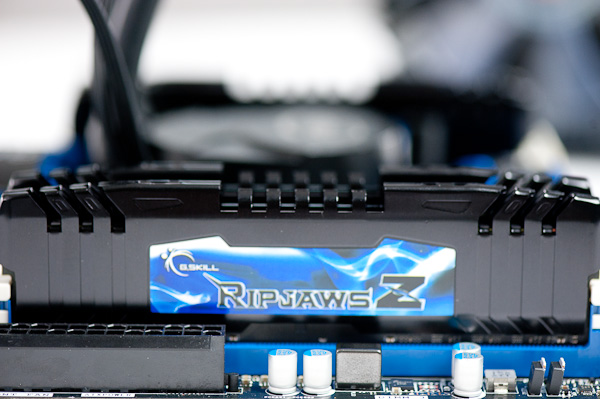
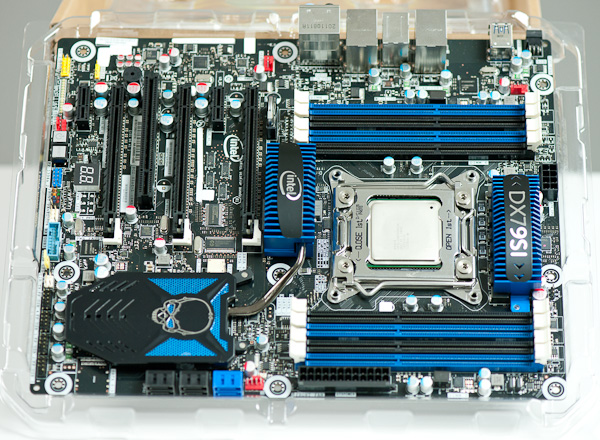
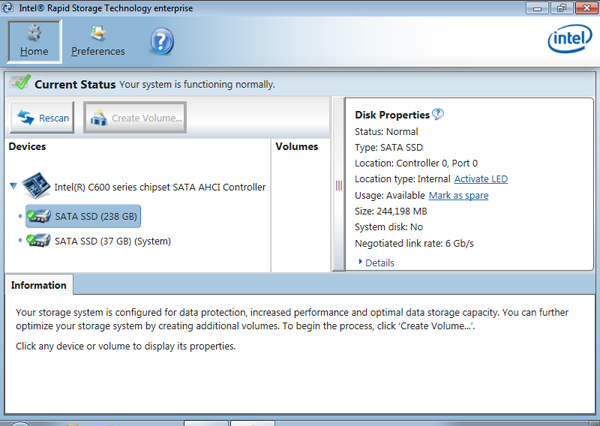








163 Comments
View All Comments
mcturkey - Monday, November 14, 2011 - link
Glad I'm not the only one who was thinking that! My 486 66 only had 4MB as well.Anand Lal Shimpi - Monday, November 14, 2011 - link
My 386 started with 4MB, but I kept it for a very long time as upgrading was fairly expensive. I eventually threw a ton of memory at it as my last upgrade to the platform :)Take care,
Anand
BSMonitor - Monday, November 14, 2011 - link
How big was your 386's hard drive?How many times over could you store it's entire contents in 8 DIMM's of DDR3 memory, now ?? And for probably less cost!
Thought I saw a 16GB kit on newegg for $75? Lol!
just4U - Monday, November 14, 2011 - link
I had a roomie 81 meg harddrive in my 386/16khanov - Monday, November 14, 2011 - link
"With the socket the same, is the reviewed SB-E the same design as the new Xeons? Will there be 3D design like Ivy Bridge?"1. It is the exact same die as the new Xeons, although of course different parts are harvested for each market.
2. Yes there will be a 3D transistor design (according to rumors) but this will be Ivy Bridge-E and will not launch until at least late 2012.
gamoniac - Monday, November 14, 2011 - link
Anand,More and more power users are running VMs on their desktops or workstation. With most Intel and AMD CPU now support Intel-VT or AMD-V, I notice a lack of measurement in this department in pretty much all online reviews. When you update your test suite, could you possibly include some sort VM test? Note: If so, could you possibly run the VM test on SSD to eliminate HDD limitation?
Thanks for the great review and conclusion, as always.
Senti - Monday, November 14, 2011 - link
I'm amazed how much fuss QuickSync is still generating in reviews. Let's face it - it's fairly useless in current state. Cool words "GPU video transcoding" can only impress casual users, not someone who cares about quality in first place and speed only after that.With time it will be even more useless if like GPU video decoding it's unable to work with 10 bit and 422/444 content (very likely).
gunslinger5577 - Monday, November 14, 2011 - link
This review indicates no significant improvement with 2x 16x PCI-E lanes in SLI. However the ASUS X79 Pro MB review seems to indicate there is a measurable and significant at times advantage.fishbits - Monday, November 14, 2011 - link
Weird stuff. Why fret over on-die USB 3.0 when every mobo supports it? And mourning Quick Sync for a CPU that flies at encoding without it? Or when you'd already have an SNB with Quick Sync? Really unhappy with the new Porche's glove compartment...Love the CPU/Platform, but too pricey for how much I'd use it over what's currently available. Hoping against hope that mainstream Ivy offers 8 RAM slots, but not holding my breath.
DanNeely - Monday, November 14, 2011 - link
Each addon chip the mobo makers include increases the cost of the board (not just the chip itself, but the engineering time needed to integrate it, and potentially (if enough are chips are added) by adding an extra layer to the PCB).You also take a hit in the number of PCIe lanes available for expansion slots. With legacy PCI gone from the southbridge we're unlikely to see any 4x electrical slots coming off of it. Audio, ethernet, and firewire, will take 1 lane each; USB3 controllers will take 1lane/2 ports, probably 3lanes total/board leaving only 2 for expansion slots. THe main impact here is just not being able to go all USB3 for the legacy free gloss without a major squeeze elsewhere. Scientific customers doing stuff that actually needs the PCE 3.0 bandwidth without needing 2x width cards could end up being dinged since it means several fewer total lanes for them to hook stuff up to.